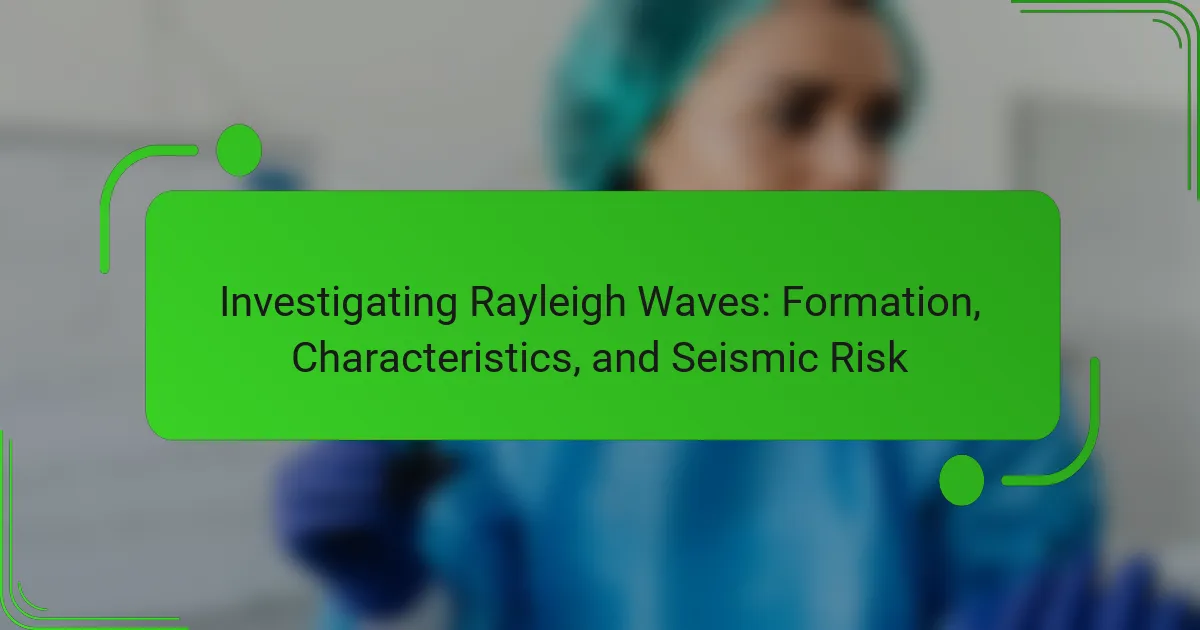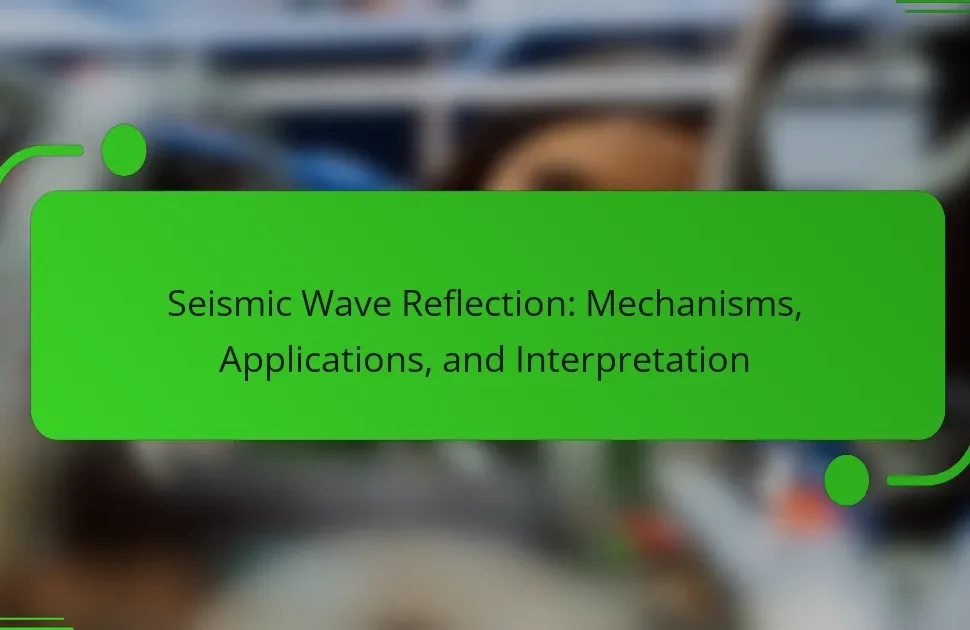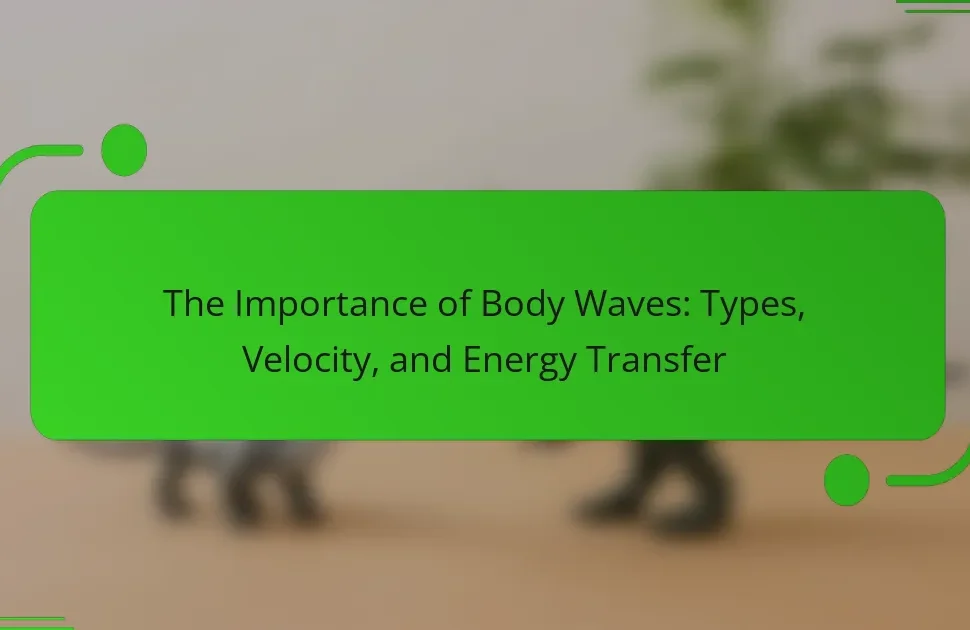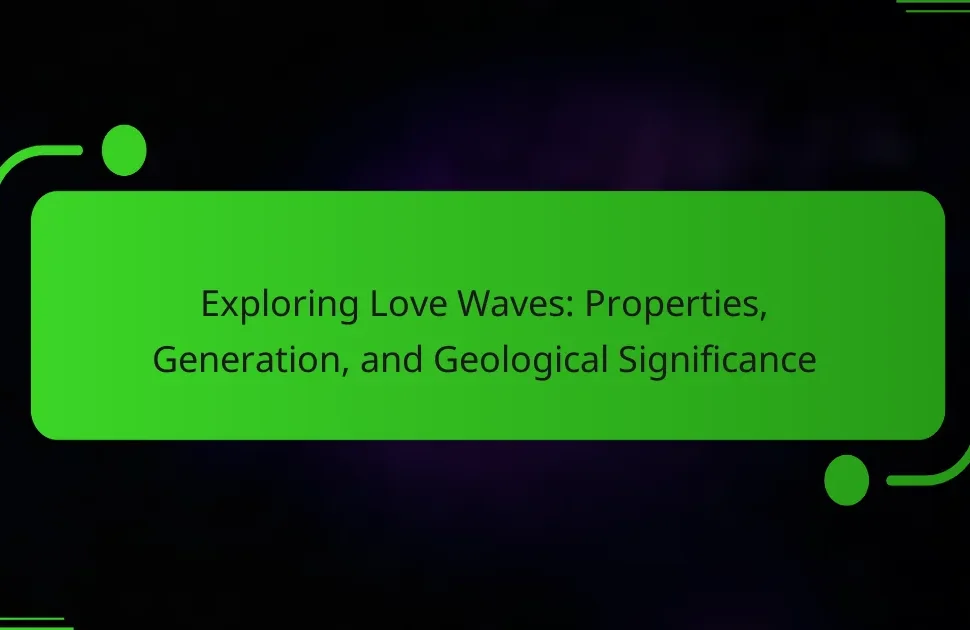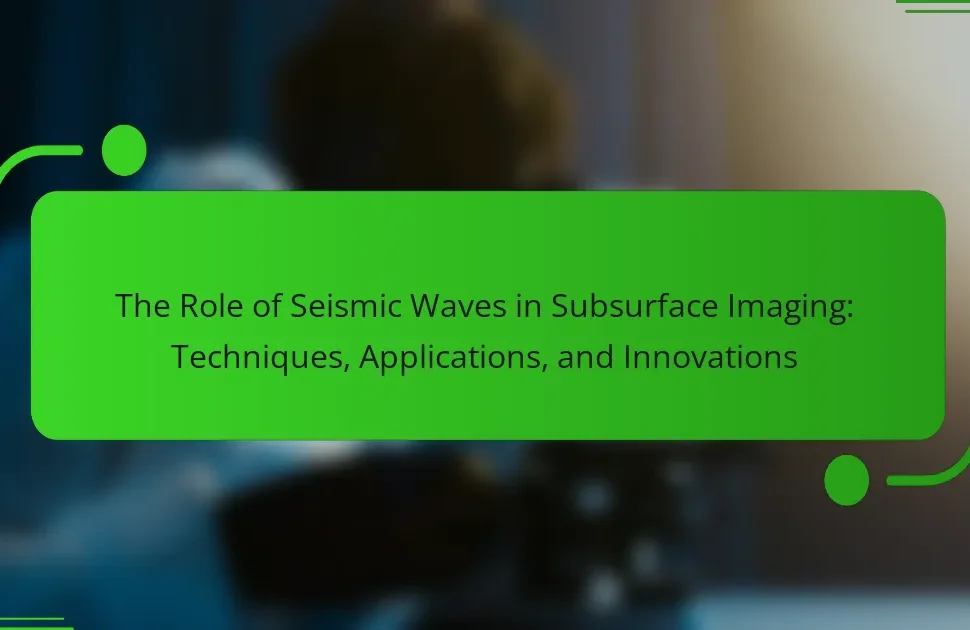Rayleigh waves are a significant type of surface seismic wave that propagate along the Earth’s surface, characterized by their rolling motion, which induces both vertical and horizontal ground movement. Their impact is critical during earthquakes, often causing substantial damage to structures and landscapes due to their ability to travel long distances and create intense ground shaking. Recent advancements in research have led to improved detection methods and modeling techniques, utilizing machine learning to enhance the interpretation of Rayleigh wave patterns. This article will explore the formation and characteristics of Rayleigh waves, their role in seismic risk assessment, and the latest technological developments aimed at mitigating their effects during seismic events.
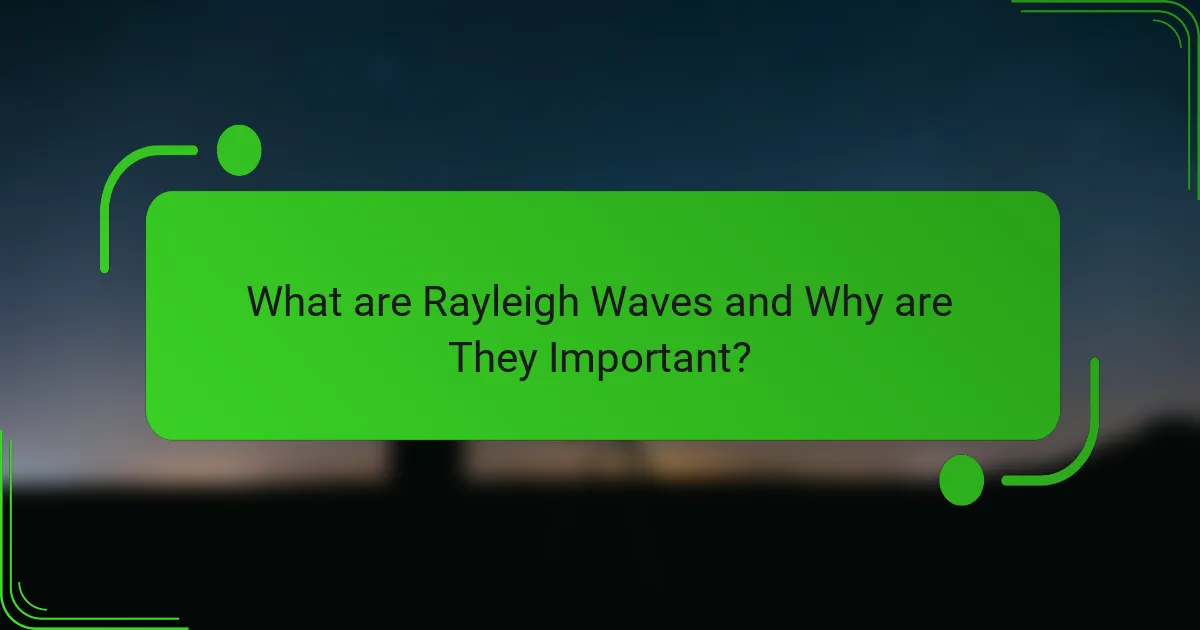
What are Rayleigh Waves and Why are They Important?
Rayleigh waves are a type of surface seismic wave that travels along the Earth’s surface. They are characterized by a rolling motion that causes both vertical and horizontal ground movement. This wave type is named after Lord Rayleigh, who studied their properties in the 19th century. Rayleigh waves are important because they are responsible for much of the damage during earthquakes. Their energy can lead to significant ground shaking, affecting structures and landscapes. Studies show that Rayleigh waves can travel long distances, making them crucial for seismic monitoring and understanding earthquake dynamics. Their analysis helps in assessing seismic risk and improving building codes for earthquake-prone areas.
How do Rayleigh Waves form during seismic events?
Rayleigh waves form during seismic events through the interaction of seismic energy with the Earth’s surface. When an earthquake occurs, it generates seismic waves that travel through the Earth. Some of these waves reach the surface and create Rayleigh waves. Rayleigh waves move in an elliptical motion, causing both vertical and horizontal ground movement. This motion occurs as the wave travels along the surface, affecting the ground and structures. The formation of Rayleigh waves is a result of the combination of P-waves and S-waves interacting at the surface. They are typically slower than both P-waves and S-waves, which contributes to their distinct effects during an earthquake. Rayleigh waves can cause significant damage due to their rolling motion and longer duration compared to other seismic waves.
What conditions are necessary for the generation of Rayleigh Waves?
Rayleigh waves are generated under specific conditions involving surface interactions. They occur when seismic energy travels through a medium, typically during an earthquake. A key condition is the presence of a free surface, such as the Earth’s crust. This surface allows the seismic waves to propagate and form the elliptical motion characteristic of Rayleigh waves. Additionally, the wave speed must be slower than that of the compressional waves in the medium. This relationship enables the formation of surface waves that exhibit both vertical and horizontal motion. The interaction of these factors leads to the generation of Rayleigh waves during seismic events.
In what geological settings are Rayleigh Waves most commonly produced?
Rayleigh Waves are most commonly produced in geological settings where there is an interface between different materials, such as the Earth’s crust and surface. These waves typically occur during seismic events like earthquakes. They can also be generated by surface explosions or landslides. The presence of sedimentary layers enhances the generation of Rayleigh Waves. Additionally, they are more prominent in regions with soft soil or unconsolidated sediments. Their propagation is influenced by the geological structure and the material properties of the subsurface. Studies indicate that Rayleigh Waves are crucial in assessing seismic risk due to their impact on surface structures.
What are the key characteristics of Rayleigh Waves?
Rayleigh Waves are a type of surface seismic wave. They travel along the Earth’s surface and cause both vertical and horizontal ground motion. This dual motion results in a rolling effect, similar to ocean waves. Rayleigh Waves typically have longer wavelengths than body waves. Their speed is slower than that of P-waves and S-waves. They are often responsible for the most damage during earthquakes. This is due to their energy being concentrated near the surface. Studies show that Rayleigh Waves can travel great distances, affecting areas far from the earthquake’s epicenter.
How do Rayleigh Waves differ from other types of seismic waves?
Rayleigh waves differ from other types of seismic waves in their motion and propagation characteristics. They travel along the surface of the Earth, causing both vertical and horizontal ground movement. This dual motion creates a rolling effect, similar to ocean waves. In contrast, primary (P) waves are compressional and travel through solids and fluids, while secondary (S) waves are shear waves that only move through solids. Rayleigh waves typically have slower velocities compared to P and S waves. Their surface-level impact can cause significant damage during earthquakes, making them particularly important in seismic studies.
What are the typical speed and amplitude of Rayleigh Waves?
Rayleigh Waves typically travel at speeds of 90% of the shear wave velocity in the medium. Their amplitude can vary but is generally about 0.1 to 0.5 times the amplitude of the surface motion. In geological terms, if the shear wave velocity is 3 km/s, Rayleigh Waves would travel at approximately 2.7 km/s. The amplitude is influenced by factors such as the distance from the epicenter and the geological structure. Studies show that Rayleigh Waves can cause significant ground shaking during seismic events, impacting structures and landscapes.
What role do Rayleigh Waves play in seismic risk assessment?
Rayleigh waves significantly influence seismic risk assessment. They are surface waves that travel along the Earth’s exterior. Their motion causes vertical and horizontal ground displacement. This movement can lead to structural damage during an earthquake. Rayleigh waves typically have larger amplitudes than other seismic waves. Their prolonged duration can increase shaking intensity. Consequently, engineers consider Rayleigh waves in building design and safety evaluations. Historical data shows that areas with high Rayleigh wave activity experience greater damage.
How can Rayleigh Waves contribute to the understanding of earthquake impact?
Rayleigh waves contribute to understanding earthquake impact by revealing information about the Earth’s subsurface structure. They are surface seismic waves that travel along the ground. Their motion causes both vertical and horizontal ground displacement. This dual motion helps in assessing the potential damage to structures.
Rayleigh waves are slower than other seismic waves, allowing for analysis of the earthquake’s effects over time. They can provide insights into the energy distribution during an earthquake. Measuring their amplitude and frequency helps in estimating the earthquake’s magnitude.
Research indicates that Rayleigh waves are crucial for evaluating building responses during seismic events. Studies have shown that their characteristics correlate with damage patterns observed in affected areas. This relationship enhances the understanding of how different geological conditions influence earthquake impact.
What methods are used to measure Rayleigh Waves in seismic studies?
Rayleigh Waves in seismic studies are measured using various methods. One common method is the use of seismographs, which detect ground motion. These instruments record the amplitude and frequency of waves. Another method involves array techniques, where multiple sensors are placed in a line to capture wave propagation. This helps in analyzing the wave’s speed and direction. Additionally, numerical modeling can simulate Rayleigh Waves based on geological data. This method provides insights into wave behavior in different soil conditions. Each of these methods contributes to a comprehensive understanding of Rayleigh Wave characteristics.
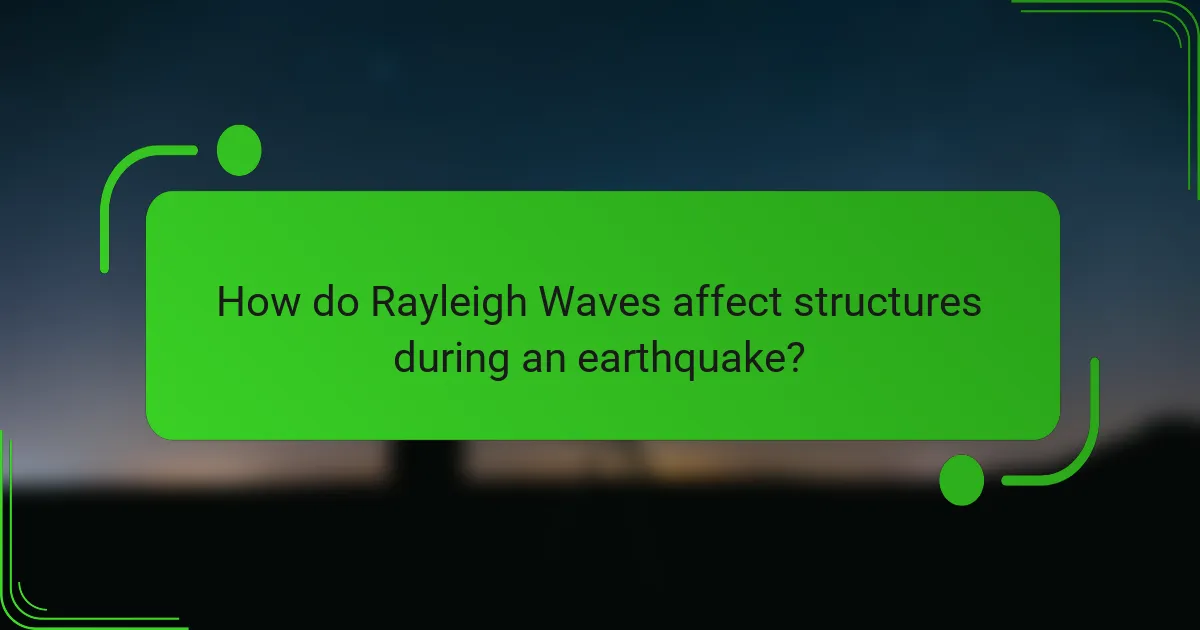
How do Rayleigh Waves affect structures during an earthquake?
Rayleigh waves affect structures during an earthquake by causing vertical and horizontal ground motion. This motion can lead to significant damage to buildings and infrastructure. Rayleigh waves typically travel along the surface of the earth and are slower than other seismic waves. They can cause the ground to roll, which can be particularly harmful to tall structures. The amplitude of Rayleigh waves can increase as they approach the surface, intensifying their impact. Studies have shown that structures with poor foundational support are more vulnerable to Rayleigh wave effects. For instance, the 2011 Japan earthquake demonstrated how Rayleigh waves contributed to extensive damage in urban areas. Proper engineering and design can mitigate the risks associated with Rayleigh waves during seismic events.
What types of damage can Rayleigh Waves cause to buildings?
Rayleigh waves can cause significant damage to buildings during an earthquake. They produce vertical and horizontal ground motion. This motion can lead to structural failure in buildings, especially those not designed for seismic activity. Common types of damage include cracks in walls and foundations. Roofs may also suffer from dislodgment or collapse. Additionally, non-structural elements like windows and facades can break or detach. Buildings with poor construction materials are particularly vulnerable. Historical earthquakes have demonstrated these effects, such as the 1906 San Francisco earthquake, where Rayleigh waves contributed to widespread destruction.
How does the frequency of Rayleigh Waves influence structural integrity?
The frequency of Rayleigh waves significantly influences structural integrity. Higher frequency Rayleigh waves tend to cause more damage to structures. This is due to their ability to induce greater accelerations and displacements. Structures with lower natural frequencies are more susceptible to resonance. When the frequency of Rayleigh waves matches a structure’s natural frequency, it can lead to catastrophic failure. Research indicates that buildings designed to withstand specific frequencies perform better during seismic events. For example, structures built with flexible materials can absorb higher frequency waves more effectively. Thus, understanding the frequency of Rayleigh waves is crucial for engineering resilient buildings.
What materials are most vulnerable to Rayleigh Wave impacts?
Materials most vulnerable to Rayleigh Wave impacts include soft soils, unconsolidated sediments, and weakly bonded materials. Soft soils can amplify seismic waves, leading to greater damage. Unconsolidated sediments lack cohesion, making them susceptible to displacement. Weakly bonded materials, such as certain types of concrete, can fracture under wave stress. These materials often experience significant structural failure during seismic events. Studies show that buildings on these substrates are at higher risk of damage. Research indicates that Rayleigh Waves cause surface motion that exacerbates vulnerabilities in these materials.
Why is it crucial to study Rayleigh Waves in urban planning?
Studying Rayleigh Waves is crucial in urban planning because they significantly impact building stability during earthquakes. Rayleigh Waves cause ground shaking that can lead to structural damage. Urban areas often have high population densities and critical infrastructure. Understanding the behavior of these waves helps engineers design safer structures. Research indicates that Rayleigh Waves can travel long distances, affecting areas far from the epicenter. This knowledge is vital for effective disaster preparedness and response strategies. Additionally, studying these waves aids in identifying vulnerable locations within cities. Accurate assessments can guide zoning laws and construction regulations.
How can knowledge of Rayleigh Waves improve building codes?
Knowledge of Rayleigh Waves can significantly enhance building codes by informing structural design to withstand seismic activity. Rayleigh Waves, a type of surface seismic wave, cause ground motion that can lead to building damage. Understanding their propagation characteristics allows engineers to predict potential impacts on structures during an earthquake.
Building codes can be updated to include specific guidelines for materials and designs that resist the effects of these waves. For instance, structures can be designed with flexible materials that absorb wave energy. Additionally, knowledge of Rayleigh Wave frequency can help determine appropriate building heights and shapes for stability.
Research indicates that buildings designed with Rayleigh Wave considerations experience less damage during seismic events. For example, the 2011 Tōhoku earthquake demonstrated the significance of surface waves in building performance. Implementing code changes based on this knowledge can lead to safer urban environments in earthquake-prone areas.
What strategies can cities implement to mitigate Rayleigh Wave effects?
Cities can implement several strategies to mitigate Rayleigh Wave effects. These include reinforcing building structures to withstand seismic forces. Retrofitting older buildings with modern materials enhances their resilience. Urban planning can also minimize risk by avoiding construction in high-risk areas. Implementing early warning systems helps alert residents before seismic events occur. Additionally, conducting regular seismic assessments ensures that infrastructure remains safe. Public education programs can inform citizens about safety measures during earthquakes. Lastly, investing in advanced engineering solutions further reduces damage from Rayleigh Waves. These strategies collectively enhance urban resilience against seismic risks.
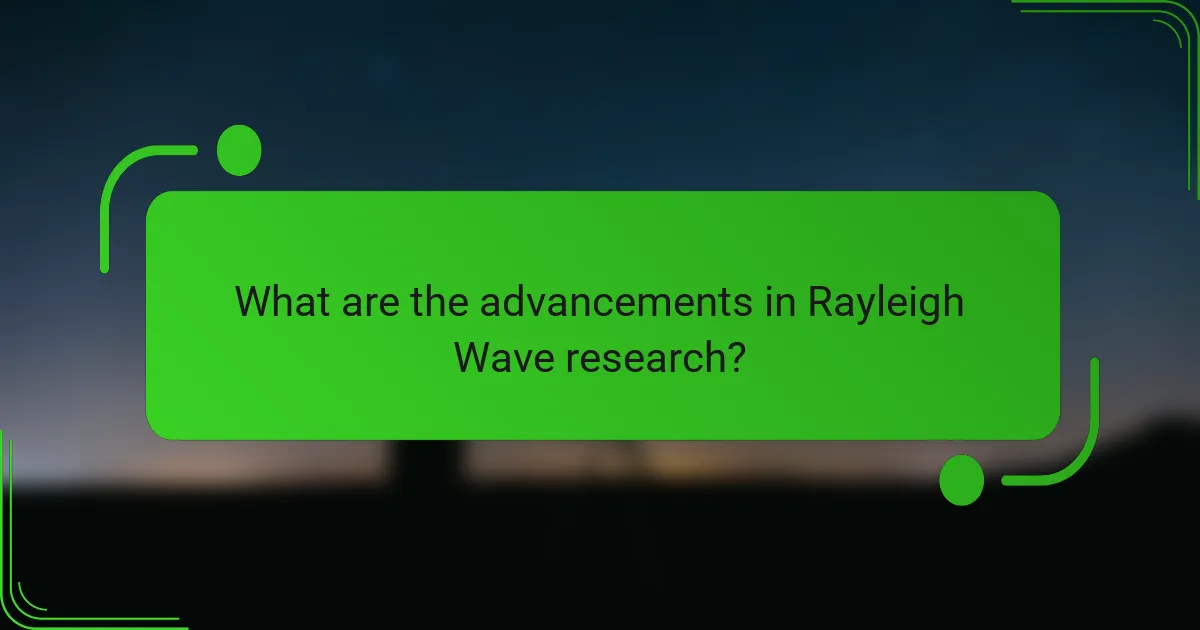
What are the advancements in Rayleigh Wave research?
Recent advancements in Rayleigh Wave research include improved detection methods and enhanced modeling techniques. Researchers have developed advanced algorithms for analyzing seismic data. These algorithms increase the accuracy of Rayleigh Wave detection in various geological settings. Additionally, machine learning techniques are now being applied to interpret Rayleigh Wave patterns more effectively. Studies have shown that these techniques can significantly reduce noise in seismic signals. Furthermore, new materials and sensors have been designed to capture Rayleigh Waves with higher sensitivity. This enhances the understanding of subsurface structures during seismic events. Recent publications highlight these advancements, demonstrating their potential to improve seismic risk assessments.
How has technology improved the detection of Rayleigh Waves?
Technology has significantly improved the detection of Rayleigh Waves through advanced seismic sensors. Modern sensors utilize high-sensitivity accelerometers that can detect minute ground movements. These devices provide real-time data on wave propagation. Enhanced data processing algorithms analyze waveforms more accurately. Machine learning techniques help in identifying and classifying wave types. The integration of GPS technology allows for precise location tracking of seismic events. Additionally, wireless communication systems enable rapid data transmission to monitoring centers. Collectively, these advancements lead to better earthquake early warning systems.
What new tools and techniques are being developed for Rayleigh Wave analysis?
Recent advancements in Rayleigh Wave analysis include machine learning algorithms and enhanced signal processing techniques. Machine learning models improve the accuracy of wave dispersion curve inversion. New signal processing methods enhance noise reduction and data interpretation. Advanced sensors are being developed for higher resolution measurements. These tools facilitate real-time monitoring of seismic activity. Improved computational models allow for faster analysis of complex waveforms. Research indicates these innovations lead to more reliable seismic risk assessments. Continued development in this field is crucial for earthquake preparedness and response.
How do these advancements enhance earthquake preparedness?
Advancements in technology enhance earthquake preparedness by providing real-time data and improved predictive models. These innovations allow for better monitoring of seismic activity. Enhanced sensor networks can detect Rayleigh waves, which are critical in assessing ground motion. Early warning systems utilize this data to alert communities before shaking occurs. Research shows that timely alerts can reduce injuries and fatalities by up to 50%. Improved building codes, informed by seismic research, increase structural resilience. These advancements collectively lead to more effective emergency response plans. Overall, they significantly mitigate the impact of earthquakes on communities.
What are the future directions for Rayleigh Wave studies?
Future directions for Rayleigh Wave studies include advancements in seismic imaging techniques. Researchers aim to enhance the resolution of subsurface structures using Rayleigh Wave data. Improved algorithms for inversion processes will lead to more accurate interpretations of wave propagation. Additionally, integrating machine learning with Rayleigh Wave analysis can optimize data processing and interpretation. Studies will increasingly focus on the impact of Rayleigh Waves on urban infrastructure and earthquake risk assessment. Researchers are also exploring the use of Rayleigh Waves in non-destructive testing for engineering applications. Collaborative efforts across disciplines will further enrich the understanding of Rayleigh Wave behavior in various geological settings.
What unresolved questions remain in Rayleigh Wave research?
Unresolved questions in Rayleigh Wave research include the precise mechanisms of their generation and propagation. Researchers seek to understand how different geological conditions affect wave behavior. The interaction of Rayleigh Waves with complex subsurface structures remains poorly understood. Additionally, the impact of Rayleigh Waves on building structures during seismic events is still being studied. There is ongoing investigation into the relationship between wave amplitude and damage potential. The influence of frequency content on the destructive capacity of Rayleigh Waves is also not fully resolved. Furthermore, the development of more accurate models to predict Rayleigh Wave behavior in various environments is a key area of focus. These questions highlight the need for continued research to enhance our understanding of Rayleigh Waves and their implications for seismic risk.
How can interdisciplinary approaches contribute to the understanding of Rayleigh Waves?
Interdisciplinary approaches enhance the understanding of Rayleigh Waves by integrating knowledge from various fields. Geophysics provides insights into wave propagation and seismic behavior. Mathematics aids in modeling wave equations and analyzing waveforms. Engineering contributes to the design of structures that can withstand seismic events.
Collaboration with computer science allows for advanced simulations and data analysis. Earth sciences offer context regarding geological formations affecting wave behavior. Psychology helps in understanding public perception of seismic risks.
Research shows that interdisciplinary studies lead to more comprehensive seismic risk assessments. For example, a study by the US Geological Survey highlights the importance of integrating geophysical data with engineering practices for improved safety measures.
What practical steps can individuals take to prepare for Rayleigh Wave impacts?
Individuals can prepare for Rayleigh Wave impacts by securing their homes and creating emergency plans. First, they should identify and reinforce weak structures in their homes. This includes securing heavy furniture and appliances to walls. Next, individuals should create an emergency kit with essential supplies. This kit should contain water, food, first aid supplies, and a flashlight.
Additionally, developing a family communication plan is crucial. This plan should outline how family members will contact each other during an emergency. Individuals should also stay informed about seismic activity in their area. They can do this by following local news and utilizing earthquake alert apps.
Practicing earthquake drills can help individuals respond effectively during an event. Regularly reviewing safety procedures can increase preparedness. Finally, individuals should consider retrofitting their homes if they live in high-risk areas. This can help minimize damage from seismic events.
Rayleigh waves are a type of surface seismic wave characterized by a rolling motion that causes both vertical and horizontal ground movement, primarily generated during seismic events like earthquakes. This article explores the formation, characteristics, and significance of Rayleigh waves in seismic risk assessment, detailing their impact on structures and the geological conditions that enhance their generation. Key aspects include their propagation behavior, the types of damage they can cause, and advancements in detection and analysis methods that improve earthquake preparedness. The discussion also highlights the importance of understanding Rayleigh waves for urban planning and building code enhancements to mitigate seismic risks.
